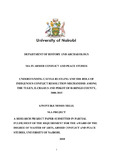| dc.description.abstract | This study was on understanding cattle rustling and application of indigenous conflict resolution mechanisms among the Tugen, Ilchamus and Pokot of Baringo County. The study sought to assess the hypotheses that cattle rustling activities have been rampant in the County since 2000. Violent conflicts involving pastoralists in Baringo County are widespread and severe.
In analysing the data, the study used Opportunity Theory by Cohen Lawrence, Ray Jeffrey and Land Kenneth. The theory argues that human actions including tendency to commit a crime (for instance, cattle rustling) is motivated by existence of systemic gaps in institutions charged with responsibilities of curbing such vices. The research utilised both primary and secondary data. The study interviewed 22 respondents and held 4 focus group discussions with respondents from the three communities, plus government officials in the study area. Respondents were picked by use of snowball and random sampling techniques based on researcher’s prior knowledge of key respondents.
The study established that pastoralists in the area are largely nomadic, living primarily in arid / semi-arid areas and depend on livestock for their livelihood. Among the factors contributing to conflict in the area are rampant cattle raids, proliferation of illicit arms, inadequate policing and inadequate security arrangements, diminishing role of traditional governance systems and competition over access to natural resources. The existence of crime-supportive norms in cultural set ups serve as a motivator for criminal commission in the study area.
The study argues that in Baringo, there has existed in the past and still exist indigenous mechanisms of prevention and resolution of conflicts, based majorly on elders. These are men and women of a certain age who make use of their status as the custodians of the communities’ culture and traditions to curb conflicts. However, most of the indigenous practices of conflict prevention/resolution and peace building are intra-communal, and little effort in academic or policy have been made to assess the possibility of widening the applicability of these mechanisms beyond a single community. The study established that through harmonisation of indigenous conflict resolution mechanisms, Baringo can realize peace that has been a pipe dream for long due to frequent cattle rustling and banditry in the county. | en_US |



